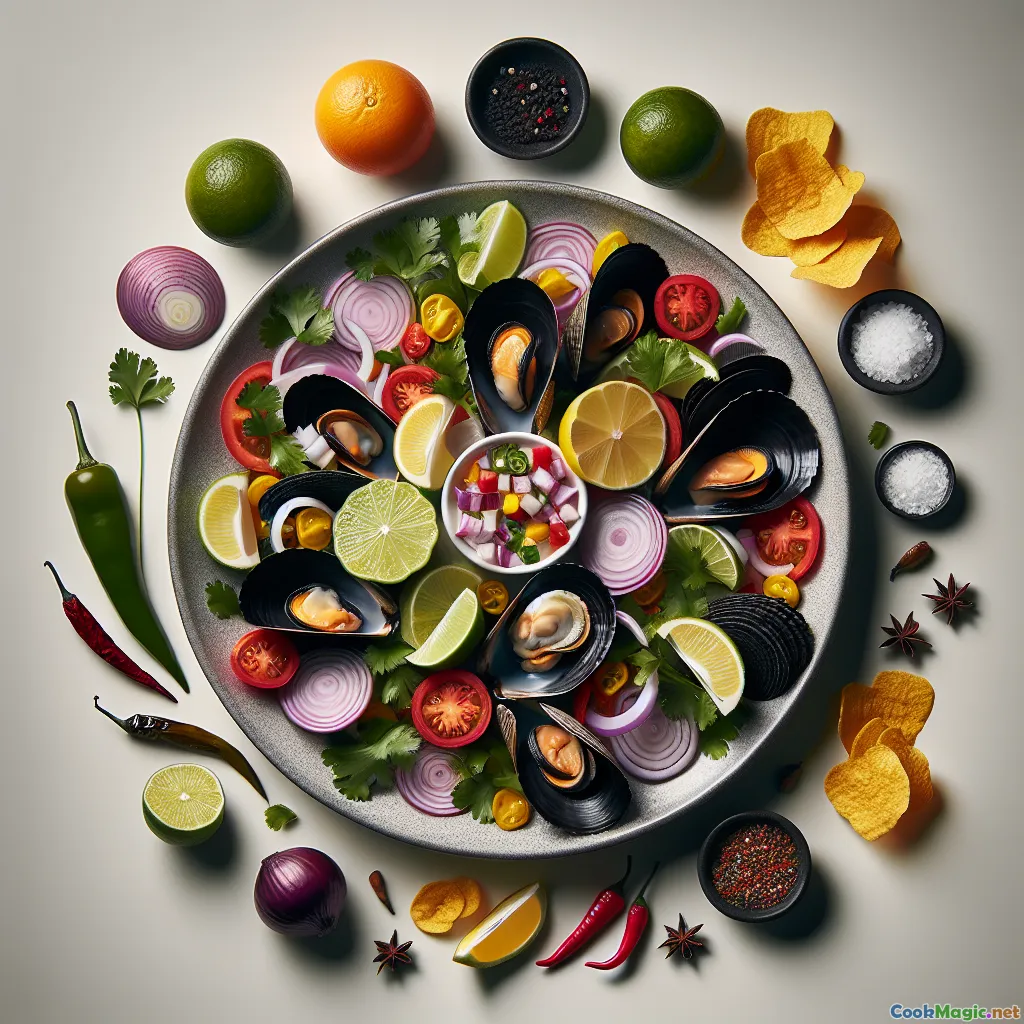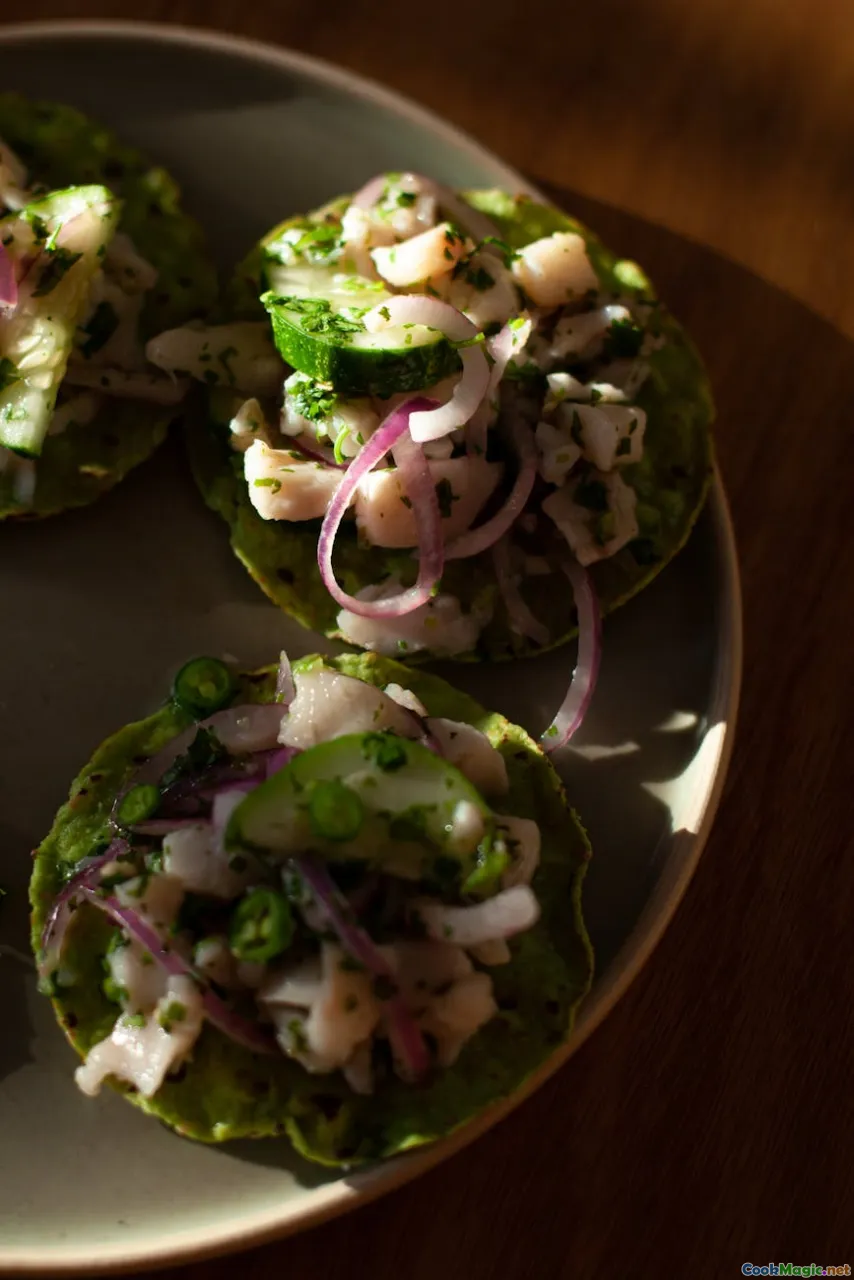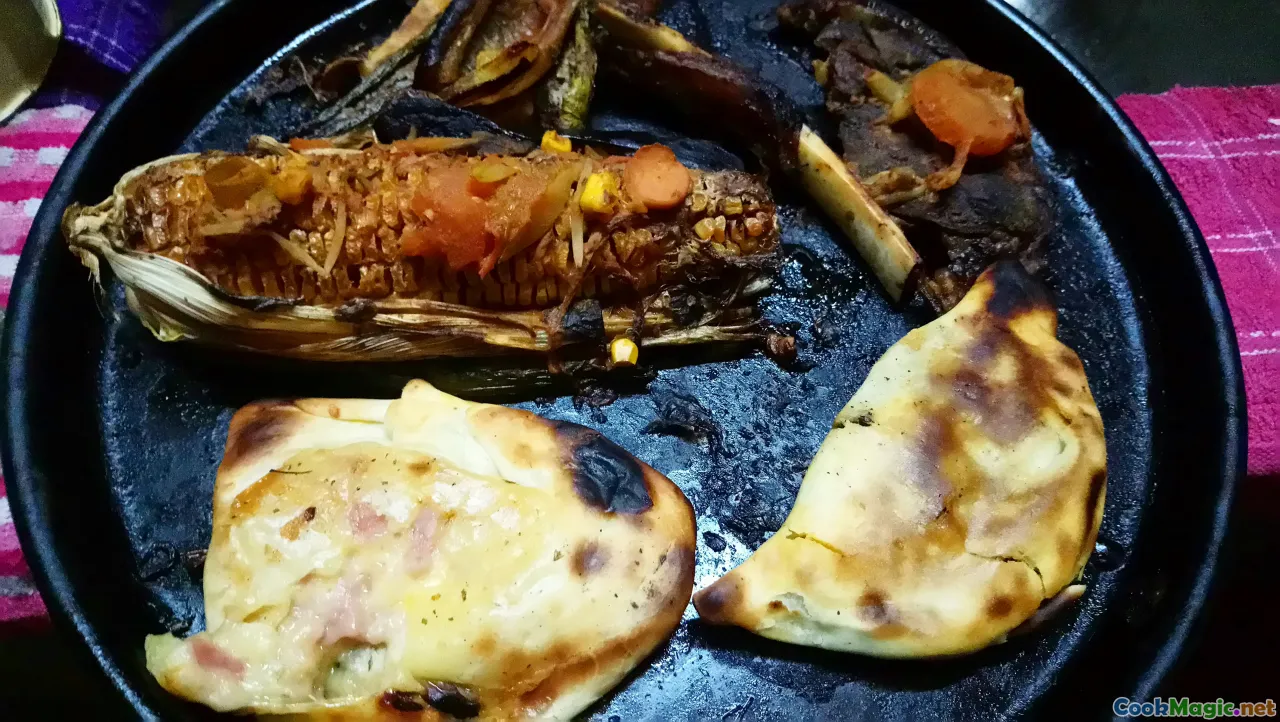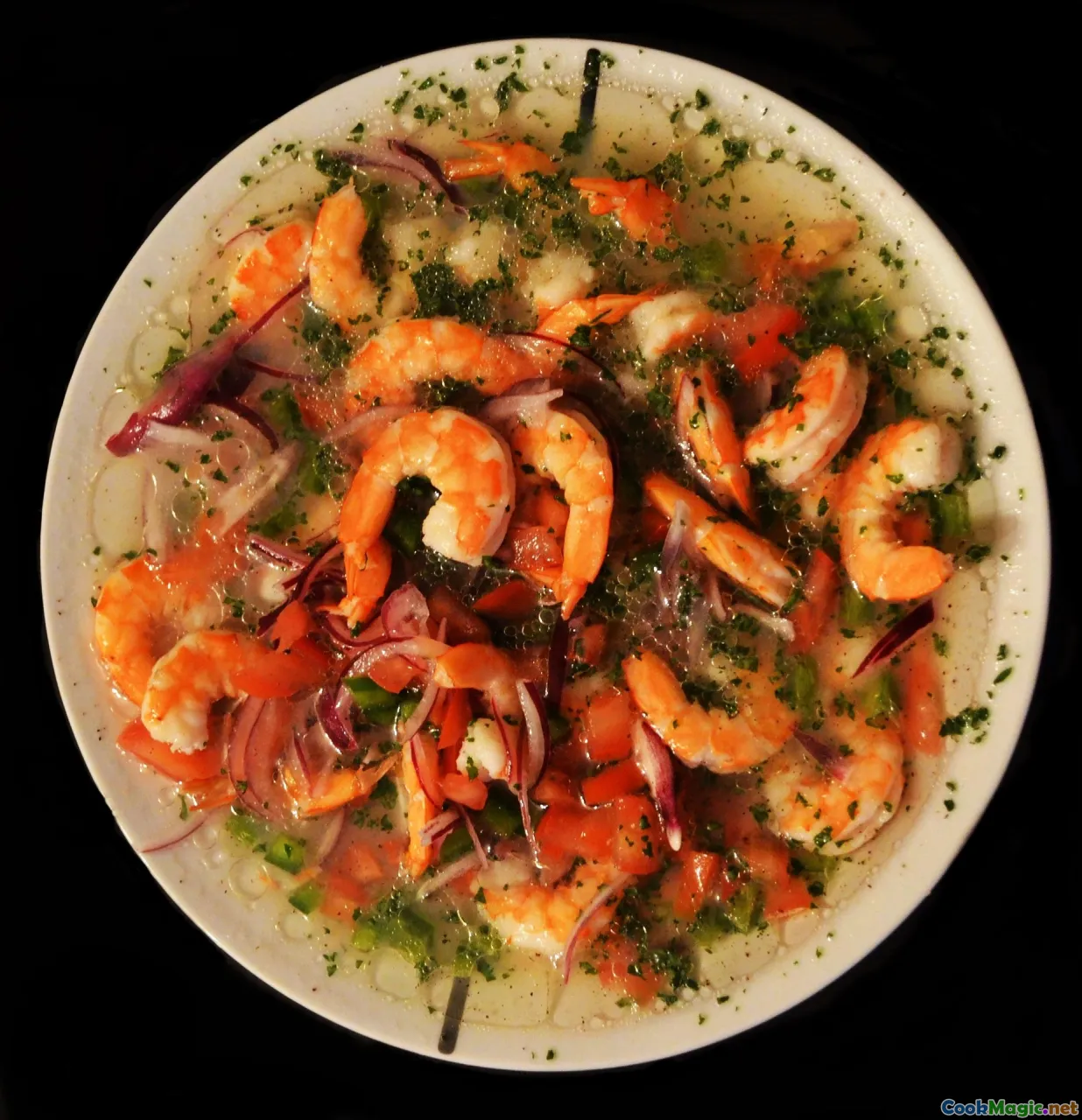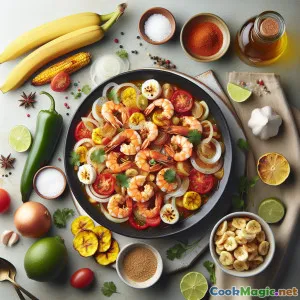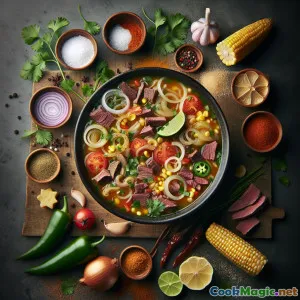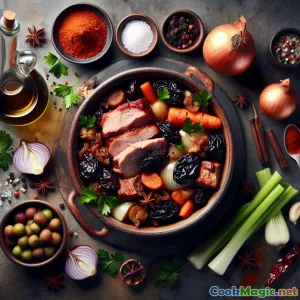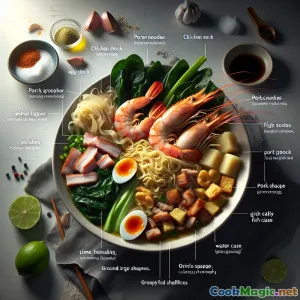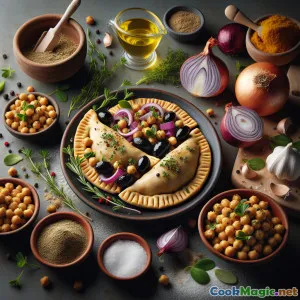
Ceviche de Mexilhão Preto Esmeraldeño
(Tangy Black Clam Ceviche Esmeraldeño Style)
(0 Avaliações)0
321
julho 16, 2025
Reportar um problema
Ingredientes
-
500 grams Concha negra (Black clams)
(Fresh, scrubbed, shells removed)
-
1 medium Cebola roxa
(Fatiado finamente)
-
8 whole Limas
(Juiced, freshly squeezed only)
-
60 ml Suco de laranja
(Fresh, not from concentrate, optional twist)
-
1/3 cup Coentro
(Finamente picado)
-
1 medium Tomate
(Picado finamente)
-
1 whole Pimenta malagueta (ají ou Serrano)
(Finely minced, optional by heat tolerance)
-
1 tsp Sal
(Ajuste a gosto)
-
1/2 tsp Pimenta preta
-
1/4 tsp Cominho
(Optional, for authentic aroma)
-
30 grams Milho assado (chifles ou milho tostado)
(Para guarnição e crocância)
-
40 grams Batatas chips
(Opcional, para servir)
(Fresh, scrubbed, shells removed)
(Fatiado finamente)
(Juiced, freshly squeezed only)
(Fresh, not from concentrate, optional twist)
(Finamente picado)
(Picado finamente)
(Finely minced, optional by heat tolerance)
(Ajuste a gosto)
(Optional, for authentic aroma)
(Para guarnição e crocância)
(Opcional, para servir)
Nutrição
- Porções: 4
- Tamanho da Porção: 1 tigela (250g)
- Calories: 220 kcal
- Carbohydrates: 23 g
- Protein: 17 g
- Fat: 3 g
- Fiber: 4 g
- Sugar: 6 g
- Sodium: 650 mg
- Cholesterol: 75 mg
- Calcium: 100 mg
- Iron: 6 mg
Instruções
-
1 - Clean and Prepare Clams:
Thoroughly clean black clams under cold water. Use a soft brush to scrub shells if necessary. Shuck clams and place meat in a colander, gently rinsing away residual sand.
-
2 - Macerate the Onion:
Soak thinly sliced red onion in ice water for 5 minutes to mellow its flavor. Drain well before use.
-
3 - Mix Ceviche Base:
Place clean clam meat in a non-reactive bowl. Add lime juice, orange juice (if using), salt, pepper, and cumin. Stir gently.
-
4 - Add Vegetables and Flavor:
Fold in cilantro, macerated onion, minced aji (if desired), and tomato. Mix to combine.
-
5 - Marinate Ceviche:
Cover bowl and refrigerate for 8–15 minutes, allowing the citrus to 'cook' the clams and the flavors to meld.
-
6 - Serve and Garnish:
Serve chilled in small bowls. Finish with fresh cilantro, roasted corn, and plantain chips on the side as desired.
Thoroughly clean black clams under cold water. Use a soft brush to scrub shells if necessary. Shuck clams and place meat in a colander, gently rinsing away residual sand.
Soak thinly sliced red onion in ice water for 5 minutes to mellow its flavor. Drain well before use.
Place clean clam meat in a non-reactive bowl. Add lime juice, orange juice (if using), salt, pepper, and cumin. Stir gently.
Fold in cilantro, macerated onion, minced aji (if desired), and tomato. Mix to combine.
Cover bowl and refrigerate for 8–15 minutes, allowing the citrus to 'cook' the clams and the flavors to meld.
Serve chilled in small bowls. Finish with fresh cilantro, roasted corn, and plantain chips on the side as desired.
Mais sobre: Ceviche de Mexilhão Preto Esmeraldeño
Ceviche de Concha Negra Esmeraldeño: History, Culture, and Culinary Insights
Ceviche de Concha Negra Esmeraldeño is one of Ecuador’s most coveted coastal delicacies, steeped in traditions and abounding with regional influences. Originating from the northern province of Esmeraldas—an area famed for its Afro-Ecuadorian heritage and vibrant seafood fare—this ceviche diverges strikingly from its better-known cousins made with white fish or shrimp. Esmeraldas sits right along Ecuador's balmy Pacific Ocean, making fresh shellfish an immense part of the local diet.
Unique and Bold Main Ingredient
Concha negra, or black clam (Anadara tuberculosa), is distinguished by an almost inky color, robust briny flavor, and more intense savoriness compared to typical ceviche ingredients. Black clam also lends a deeper, slightly mystical color to the marinating liquid—often resulting in a purplish or jet-black consommé prized as both a delicacy and a restorative tonic. There's even a cultural belief among many locals that ceviche de concha negra is an aphrodisiac and provides a potent boost of energy.
Cultural Significance and Regional Atmosphere
The city of Esmeraldas, with its dynamic, African-Ecuadorian energy, hosts what can best be described as sensory culinary rituals. Vendors serve this ceviche piping fresh, regal in bright orange limes and lush green cilantro, at seaside markets, roadside stalls, and family homes for weekend indulgence or recados (celebrations). It’s a dish tied intimately to communal gatherings, symbolizing the abundance of the sea and the resourcefulness of coastal dwellers.
Preparation & Traditional Serving
Preparing this ceviche is both art and celebration: the clams must be fresh—often still pulsating with saline ‘life’—cleaned meticulously, and only momentarily marinated so their supple texture and natural juice remain vivid. Macerating the onions beforehand is not just a flavor technique; it’s about ensuring the layering of tastes and making the dish more palatable and refreshing on hot coastal days. The addition of orange juice isn’t strictly canonical but often used for extra sweetness or for times when limes are exceptionally tart.
Esmeraldeños frequently finish the dish with crunchy corn kernels (‘maíz tostado’) and crisp plantain chips, which provide flavor contrast and textural interest, all eaten preferably while watching the Pacific waves.
Unique Aspects & Tips
- Clam Freshness: Only use the freshest black clams you can get—texture and brininess start to diminish within hours.
- Citrus Marination: Unlike fish-based ceviches, you want the ‘cooking’ time very brief in order to preserve the clam’s soft, yielding bite.
- Optional Additions: Locals might stir in a teaspoon of cold clam broth to heighten the flavor—if your shellfish is top quality, collect and strain it!
- Herbage and Heat: While aji tends to be optional (spice tolerance in Ecuador varies regionally), a gentle sprinkle offers a wonderful kick without overshadowing the sweet-plump seafood.
Modern Enjoyment – Sustainable and Accessible
Due to overfishing and regulations on black clam harvest, availability varies, yet the dish persists as a beloved regional identity marker. For home cooks outside South America, frozen black clam meat (often from specialized Latin food markets) can offer a close approximation.
What Stands Out Most?
- The unusual color and strong ocean flavor—unmistakably different from lemony fish ceviches.
- Its symbolism as festive and even slightly “forbidden” sea magic from Ecuador’s northern shores.
Final Thoughts
To taste Ceviche de Concha Negra Esmeraldeño is to bite into the very essence of Ecuador’s glorious Pacific coast—salty breezes, warm hospitality, drums and marimbas echoing in the background, and the flavor of tradition that links past and future generations. This recipe not only delights, but feeds the adventurous soul with cultural adventure, uniqueness, and soul.
